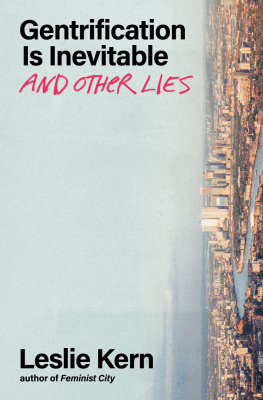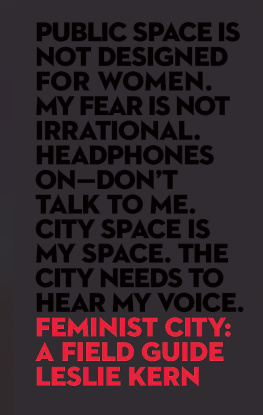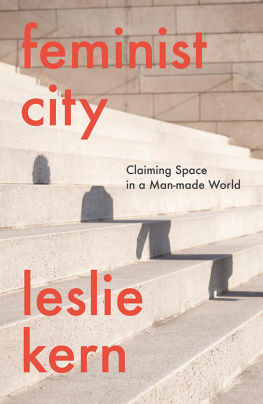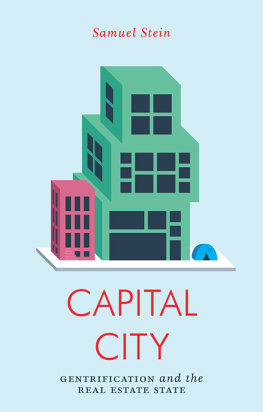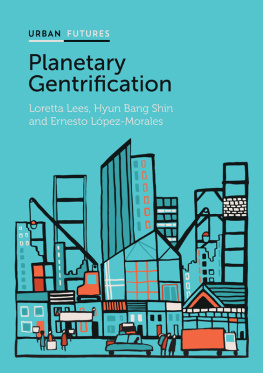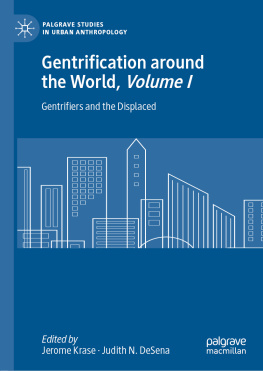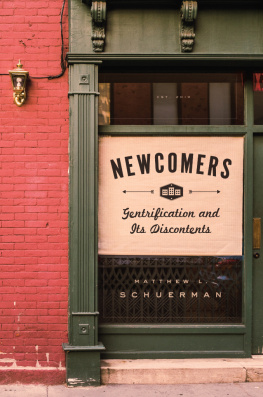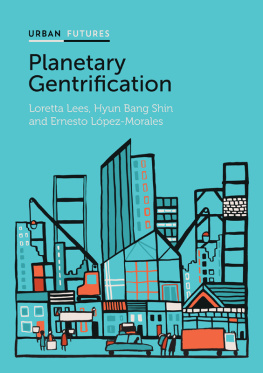Contents
Page List
Guide

If youve ever really wanted to understand what gentrification means, this is the book for you. Kern gets beyond jargon, digs into scores of city stories that show how cities have transformed, and offers trajectories for positive change.
Shawn Micallef, author of Frontier City: Toronto on the Verge of Greatness
If youve ever tried and failed to make a compelling argument against gentrification, what you meant to say is in this book, with the facts and figures to back it up. From the forced removal of Indigenous people to the redlining of Black neighbourhoods, from the disenfranchisement of women through suburbanization to the expulsion of the LGBTQ+ community, Kerns writing is a rallying cry for the decolonization of placemaking and a blueprint for an urbanism rooted in social justice and fairness.
Christine Murray, editor-in-chief of The Developer and director of the Festival of Place
Leslie Kern fills an important gap with this book and provides a service to all those needing language to counter the many, often persistent, arguments made in favour of gentrification. Activists, policy-makers, and scholars alike looking for tools and clear, concise insight into the politics of gentrification will all benefit from reading this book.
Alan Walks, professor of urban planning and geography, University of Toronto
Gentrification Is Inevitable and Other Lies
Gentrification Is Inevitable and Other Lies
Leslie Kern
BETWEEN THE LINES TORONTO
Gentrification Is Inevitable and Other Lies
2022 Leslie Kern
First published in Canada in 2022 by
Between the Lines
401 Richmond Street West, Studio 281
Toronto, Ontario M5V 3A8 Canada
1-800-718-7201 www.btlbooks.com
All rights reserved. No part of this publication may be photocopied, reproduced, stored in a retrieval system, or transmitted in any form or by any means, electronic, mechanical, recording, or otherwise, without the written permission of Between the Lines, or (for copying in Canada only) Access Copyright, 69 Yonge Street, Suite 1100, Toronto, ON M5E 1K3.
Every reasonable effort has been made to identify copyright holders. Between the Lines would be pleased to have any errors or omissions brought to its attention.
Library and Archives Canada Cataloguing in Publication
Title: Gentrification is inevitable and other lies / Leslie Kern.
Names: Kern, Leslie, 1975- author.
Description: Includes bibliographical references and index.
Identifiers: Canadiana (print) 20220149895 | Canadiana (ebook) 20220149917 | ISBN 9781771135849 (softcover) | ISBN 9781771135856 (EPUB) Subjects: LCSH: GentrificationSocial aspects. | LCSH: GentrificationCase studies.
Classification: LCC HT170 .K47 2022 | DDC 305.5dc23
Cover design by Cara Buzzell
Text design by DEEVE
Printed in Canada
We acknowledge for their financial support of our publishing activities: the Government of Canada; the Canada Council for the Arts; and the Government of Ontario through the Ontario Arts Council, the Ontario Book Publishers Tax Credit program, and Ontario Creates.

In loving memory of my father, a gentle and generous man
Contents
Acknowledgements
Thank you to Amanda Crocker, my editor at Between the Lines, for your constant encouragement and insightful feedback at every stage of this project. Leo Hollis at Verso has also been tremendously supportive and thoughtful about the orientation of this book. A huge thanks to the staff of both of these independent presses, who do amazing work behind the scenes in design, editing, and marketing. Nadine Ryan provided outstanding copy-editing services, and any remaining errors are my own.
Thank you to the Mikmaq on whose lands I have been a guest since 2009. I am honoured to have had the opportunity to live, work, and learn in the territory of Mikmaki during the writing of this book.
I am grateful for colleagues (who I also consider friends) such as Winifred Curran, whose own research and willingness to collaborate have uplifted this and other projects of mine. Michael Fox took a chance on hiring a non-geographer into a geography department and fought to keep me there. Roberta Hawkins has patiently waited for my work on this book to end so I can return to our work together.
My friends have been my biggest cheerleaders and despite distance, a pandemic, and the roller coaster of life, they remain a great joy in my life: Jennifer Kelly, Kris Weinkauf, Katherine Krupicz, Sarah Gray, Cristina Izquierdo, Michelle Mendes, Katie Haslett, Jane Dryden, Shelly Colette, and Lisa Dawn Hamilton.
Thank you to my family for always encouraging me to go far in my career and in life: Dale Kern, Ralph Kern, Josh Kern, Geof Dunn, Kathy Saunders, Charmaine Peters, and my grandparents, aunts, uncles, and cousins.
My daughter Maddy continues to inspire me to (hopefully) inspire her. My partner Peter keeps me grounded with his unfailing love and care. Thank you all.
. Gentrification Is
I used to live in a west-end Toronto neighbourhood called the Junction. Carved up and isolated at the junction of intersecting railroads, its industrial history was tangible in the sounds and smells drifting from rubber, paint, and meatpacking factories. Today, on a hot afternoon, some of those smells might waft along, but they are competing with the scents emanating from upscale cafs and vegan bakeries. I know it is a clich to talk about how gritty your neighbourhood once was, but there is a reason why we are all tired of this narrative: so many of our neighbourhoods are being remade before our very eyes.
What I witnessed in the Junction is part of a set of changes to the places and communities that have, historically, made cities special, made them interesting, made them sites of protest and progress. These changes have come to be called gentrification, and this is a book about the struggle to keep gentrification from steamrolling over everything many of us hold dear about city life.
Despite having lived in and around Toronto for over twenty years, I had never heard of the Junction before I moved there in 2000. It was an odd place: a dry (no alcohol served) neighbourhood from 1904 to 1998, its location next to Torontos historic stockyards had attracted immigrants from Malta, Italy, and Poland to work in the meat industry. Active industrial sites and meat processing plants sat next to abandoned factories and vacant lots, just blocks from the decidedly utilitarian offerings along the main commercial strip. Blockbuster Video, a discount grocery store, and the post office were some of the only retail spaces that I, as a graduate student and new mom, was likely to access. The pawn shops and strange overabundance of upholstery repair places were less appealing destinations.
What we did have were higher than average rates of air pollution, parks with discarded needles, and a largely forgotten working-class, low-income, immigrant population. I say largely forgotten because unlike other Toronto neighbourhoods stigmatized for drug use, homelessness, sex work, or crime, the Junction rarely made the news. It was not a place imagined as other or frightening. It was not imagined at all by those who lived outside the railroad triangle. When I was looking for affordable apartments, all of the Junction listings called the area High Park North, evoking the stately neighbourhood and beautiful park to the south. It was a creative piece of nomenclature designed to mask the fact that High Park, it was not.

